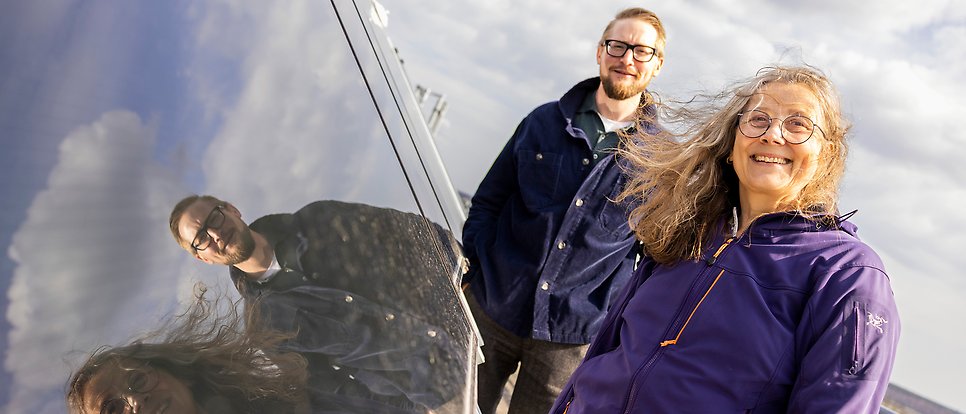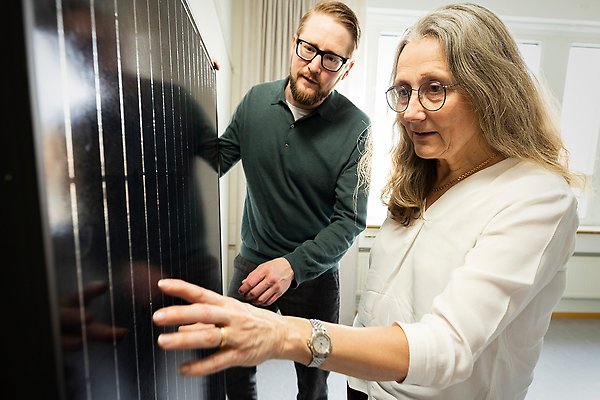Promising collaboration for solar power of the future

Jonathan Scragg and Marika Edoff (pictured) coordinate the activities within the new competence center together with project coordinator Ilknur Bayrak Pehlivan. Photo: Mikael Wallerstedt
Solar energy is seen as one of the solutions for a sustainable energy future. The road to that future requires collaboration and that is where the Solar Electricity Research Centre Sweden (SOLVE) has an important role to play in finding specific projects that interest researchers and doctoral students as well as students completing their degree projects and companies according to SOLVE’s director Marika Edoff.
“What’s so exciting is that SOLVE opens the door for companies to get involved in research beyond what they were initially interested in,” she says.
Photovoltaic (PV) or solar cell research at Uppsala University has a long tradition of material development and the production of PV (or solar) cells. Several world records in efficiency have been measured in CIGS solar cells which are made of copper, indium, gallium, and selenium or sulphur. CZTS solar cells, which are based on common elements such as zinc and tin, provide hope for more environmentally friendly and affordable alternatives. Perovskite solar cells have also proven to be effective converters of solar energy in the lab at the Ångström Laboratory.
Both cutting-edge and broad competence in the organisation
With its cutting-edge competence in PV technology combined with broad system experience, it only seems natural that Uppsala University would be the focal point for SOLVE. And after an initial year of planning, recruitments and project starts, the Centre is finally taking off.
“The twelve doctoral students employed by the Centre’s academic partners are up and running with their research projects. Most of the doctoral students also have a supervisor or mentor in the company that employs them,” says Marika Edoff, professor of solid state electronics and director of both the Division for Solar Cell Technology and SOLVE at Uppsala University.
She has long experience of leading large European networks in the field of solar energy, including the ongoing EU project SITA on tandem solar cells. Along with her colleague Jonathan Scragg and project coordinator Ilknur Bayrak Pehlivan, she coordinates the activities in the new competence centre.
How does the work in SOLVE differ from other projects?
“What differs most is the number of companies and organisations involved. In SOLVE those figures are 36 companies and two organisations, as well as 11 partners from the public sector, which is probably quite unique. Here we have many companies that are very technology-focused and committed to what they do, while at the same time it's so broad. I think that’s immensely exciting and challenging,” says Marika Edoff.

Photovoltaic (PV) or solar cell research at Uppsala University has a long tradition of material development and the production of PV (or solar) cells. From left: Jonathan Scragg och Marika Edoff. Photo: Mikael Wallerstedt
Besides Uppsala University, six other academic partners participate in SOLVE: Karlstad University, Mälardalen University, Dalarna University, the Swedish University of Agricultural Sciences, and RISE Research Institutes of Sweden AB from its non-commercial part. The key to success, she believes, is to identify specific projects that get everyone excited and involved. They could be about investigating how the technology can be made cheaper, or how solar panels on buildings affect their occupants and the buildings themselves.
“What’s so exciting is that we have sometimes been wrong about what we initially thought companies would be interested in. One of these, Midsummer, has placed great emphasis on life cycle issues in addition to the technology. Another example is the Church of Sweden, which has got involved the utilisation of agricultural land and buildings for solar panels.”
Research based on corporate data
In many cases, the companies have agreed to contribute data that is very interesting to explore for research purposes, according to Marika Edoff. Access to this data allows researchers to analyse what differences there are between a solar panel system in Piteå and one in Skåne, for example, and whether different technologies can be used to maximise the energy output.
“Region Uppsala also has solar panel systems that are combined with sedum roofs. With these, we want to find out if you can combine green roofs like this with solar panels, or if the poor plants die. Or if they are much happier because they get some shade,” says Marika Edoff and continues:
“Similar projects are also being run by the doctoral students at Mälardalen University, where they are looking at solar panels installed on cropland, where the crops are occasionally shaded by the solar panels. Combining solar panels and agriculture is a fairly new, interdisciplinary field of research, commonly called agrivoltaics.”
Catalogue of degree projects
Something she is particularly pleased about is that SOLVE is currently developing a catalogue of degree projects at Uppsala University. It allows companies to get in touch with committed, promising students.
“We’re convinced the catalogue will work well and we hope to get many students who find this field interesting. This is a future industry after all.”
Anneli Björkman
Solar Electricity Research Centre Sweden (SOLVE)
Solar Electricity Research Centre Sweden (SOLVE), is part of the Swedish Energy Agency’s investment in competence centres in sustainable energy systems during the period 2022–2026. The funding for the Centre is shared between academia, the business sector and the public sector. The Centre brings together a total of 51 partners and is managed by Uppsala University. The co-applicant higher education institutions and research institutes are the Swedish University of Agricultural Sciences, RISE Research Institutes of Sweden AB, Dalarna University, Mälardalen University and Karlstad University.
